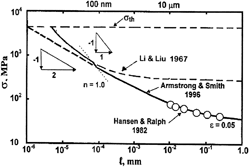Crossref Citations
This article has been cited by the following publications. This list is generated based on data provided by
Crossref.
Liu, Dabiao
He, Yuming
Zhang, Bo
and
Shen, Lei
2014.
A continuum theory of stress gradient plasticity based on the dislocation pile-up model.
Acta Materialia,
Vol. 80,
Issue. ,
p.
350.
Armstrong, Ronald W.
2014.
Engineering science aspects of the Hall–Petch relation.
Acta Mechanica,
Vol. 225,
Issue. 4-5,
p.
1013.
McCabe, Rodney J.
Carpenter, John S.
Vogel, Sven
Mara, Nathan A.
and
Beyerlein, Irene J.
2015.
Recrystallization and Grain Growth in Accumulative Roll-Bonded Metal Composites.
JOM,
Vol. 67,
Issue. 12,
p.
2810.
Yuan, Rui
Beyerlein, Irene J.
and
Zhou, Caizhi
2015.
Emergence of grain-size effects in nanocrystalline metals from statistical activation of discrete dislocation sources.
Acta Materialia,
Vol. 90,
Issue. ,
p.
169.
Zamani, Zahra
Shishvan, Siamak S.
and
Assempour, Ahmad
2015.
Effect of source strength on dislocation pileups in the presence of stress gradients.
Philosophical Magazine,
Vol. 95,
Issue. 20,
p.
2175.
Karavaeva, M. V.
Kiseleva, S. K.
Ganeev, A. V.
Protasova, E. O.
Ganiev, M. M.
Simonova, L. A.
and
Valiev, R. Z.
2015.
Superior strength of carbon steel with an ultrafine-grained microstructure and its enhanced thermal stability.
Journal of Materials Science,
Vol. 50,
Issue. 20,
p.
6730.
Baker, Ian
and
Meng, Fanling
2015.
Lamellar coarsening in Fe28Ni18Mn33Al21 and its influence on room temperature tensile behavior.
Acta Materialia,
Vol. 95,
Issue. ,
p.
124.
Armstrong, Ronald W.
2016.
Dislocation Pile-Ups, Material Strength Levels, and Thermal Activation.
Metallurgical and Materials Transactions A,
Vol. 47,
Issue. 12,
p.
5801.
Erdle, Hannes
Bayerschen, Eric
and
Böhlke, Thomas
2016.
Large Strain Gradient Plasticity Theory with a Discontinuous Grain Boundary Yield Condition.
PAMM,
Vol. 16,
Issue. 1,
p.
329.
Yuan, Rui
Beyerlein, Irene J.
and
Zhou, Caizhi
2016.
Coupled crystal orientation-size effects on the strength of nano crystals.
Scientific Reports,
Vol. 6,
Issue. 1,
Zamani, Zahra
Shishvan, Siamak Soleymani
and
Assempour, Ahmad
2016.
Stress gradient interpretation of boundary layers in passivated thin films.
International Journal of Non-Linear Mechanics,
Vol. 81,
Issue. ,
p.
139.
Armstrong, R.W.
2016.
Reference Module in Materials Science and Materials Engineering.
Andrievski, Rostislav A.
and
Khatchoyan, Arsen V.
2016.
Nanomaterials in Extreme Environments.
Vol. 230,
Issue. ,
p.
55.
Ovid'ko, I.A.
and
Sheinerman, A.G.
2017.
Grain boundary sliding, triple junction disclinations and strain hardening in ultrafine-grained and nanocrystalline metals.
International Journal of Plasticity,
Vol. 96,
Issue. ,
p.
227.
Assempour, Ahmad
Shishvan, Siamak S.
and
Zamani, Zahra
2017.
Second order stress gradient plasticity with an application to thin foil bending.
International Journal of Mechanics and Materials in Design,
Vol. 13,
Issue. 2,
p.
321.
Bobylev, S.V.
and
Ovid'ko, I.A.
2017.
Stress-driven migration, convergence and splitting transformations of grain boundaries in nanomaterials.
Acta Materialia,
Vol. 124,
Issue. ,
p.
333.
Cash, Caitlin E.
Wang, Jeremy
Martirossyan, Maya M.
Ludlow, B. Kemper
Baptista, Alejandro E.
Brown, Nina M.
Weissler, Eli J.
Abacousnac, Jatin
and
Gerbode, Sharon J.
2018.
Local Melting Attracts Grain Boundaries in Colloidal Polycrystals.
Physical Review Letters,
Vol. 120,
Issue. 1,
Armstrong, Ronald W.
2019.
Size effects on material yield strength/deformation/fracturing properties.
Journal of Materials Research,
Vol. 34,
Issue. 13,
p.
2161.
Chen, Tianju
Yuan, Rui
Beyerlein, Irene J.
and
Zhou, Caizhi
2020.
Predicting the size scaling in strength of nanolayered materials by a discrete slip crystal plasticity model.
International Journal of Plasticity,
Vol. 124,
Issue. ,
p.
247.
Schoeman, Liezl
Nsiengani, Emmanuel N.
Sole, Kathryn C.
and
Sandenbergh, Roelf
2020.
Effect of aluminium on polarisation parameters and deposit characteristics in typical nickel sulfate electrolyte for electrowinning applications.
Hydrometallurgy,
Vol. 194,
Issue. ,
p.
105332.


